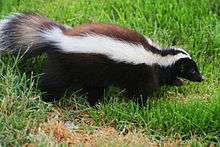Humboldt's hog-nosed skunk
| Humboldt's hog-nosed skunk | |
|---|---|
 | |
| Scientific classification | |
| Kingdom: | Animalia |
| Phylum: | Chordata |
| Class: | Mammalia |
| Order: | Carnivora |
| Family: | Mephitidae |
| Genus: | Conepatus |
| Species: | C. humboldtii |
| Binomial name | |
| Conepatus humboldtii Gray, 1837 | |
 | |
| Humboldt's hog-nosed skunk range | |
Humboldt's hog-nosed skunk, also known as the Patagonian hog-nosed skunk (Conepatus humboldtii) is a type of hog-nosed skunk indigenous to the open grassy areas in the Patagonian regions of Argentina and Chile.
Appearance
This skunk is small and stocky, with a bare nose used for rooting up insects and plants. Its fur is brownish-red with two symmetrical stripes on either side, extending to the tail. It ranges from 30–34 cm in body length, with a 17- to 21-cm tail. They usually weigh 1.5 to 3.0 kg.
Food
Patagonian hog-nosed skunks are primarily insectivorous, but also eat vertebrate prey, such as rodents and carrion during winters, when insects are less abundant.[2]
References
- ↑ Emmons, L. & Helgen, K. (2008). "Conepatus humboldtii". IUCN Red List of Threatened Species. Version 2008. International Union for Conservation of Nature. Retrieved 27 January 2009.
- ↑ Zapata, Sonia C.; Travaini, Alejandro; Martínez-Peck, Rolando (January 2001), "Seasonal feeding habits of the Patagonian hog-nosed skunk Conepatus humboldtii in southern Patagonia", Acta Theriologica, 46: 97–102
Extant species of family Mephitidae | |
|---|---|
| |
| Conepatus | |
| Mydaus | |
| Mephitis | |
| Spilogale | |
Category | |
This article is issued from Wikipedia - version of the 11/7/2016. The text is available under the Creative Commons Attribution/Share Alike but additional terms may apply for the media files.
